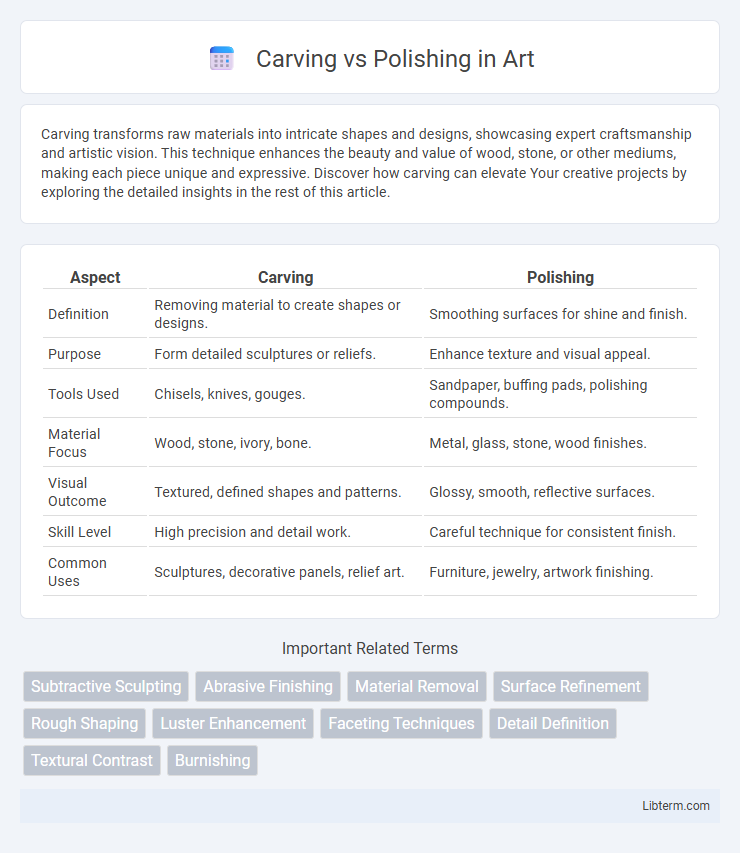Carving transforms raw materials into intricate shapes and designs, showcasing expert craftsmanship and artistic vision. This technique enhances the beauty and value of wood, stone, or other mediums, making each piece unique and expressive. Discover how carving can elevate Your creative projects by exploring the detailed insights in the rest of this article.
Table of Comparison
| Aspect | Carving | Polishing |
|---|---|---|
| Definition | Removing material to create shapes or designs. | Smoothing surfaces for shine and finish. |
| Purpose | Form detailed sculptures or reliefs. | Enhance texture and visual appeal. |
| Tools Used | Chisels, knives, gouges. | Sandpaper, buffing pads, polishing compounds. |
| Material Focus | Wood, stone, ivory, bone. | Metal, glass, stone, wood finishes. |
| Visual Outcome | Textured, defined shapes and patterns. | Glossy, smooth, reflective surfaces. |
| Skill Level | High precision and detail work. | Careful technique for consistent finish. |
| Common Uses | Sculptures, decorative panels, relief art. | Furniture, jewelry, artwork finishing. |
Introduction to Carving and Polishing
Carving involves the precise removal of material to shape or detail objects, often using tools like chisels, knives, or rotary instruments to achieve intricate designs. Polishing focuses on refining surfaces by smoothing and enhancing shine through abrasives, buffing pads, or polishing compounds to improve appearance and texture. Both techniques serve distinct purposes in the finishing process, with carving emphasizing form and structure, while polishing enhances surface quality and visual appeal.
Defining Carving: Techniques and Tools
Carving involves the precise removal of material from a surface using specialized tools such as chisels, gouges, and knives to create intricate designs or shapes. Techniques vary depending on the medium, including wood, stone, or ice, with hand carving emphasizing control and detail while power carving uses rotary tools for efficiency. Mastery of specific carving methods and tool selection is essential for achieving desired textures and depth in artistic or functional projects.
Understanding Polishing: Process and Methods
Polishing is a surface finishing process designed to enhance smoothness and shine by removing fine scratches and imperfections, using abrasives such as polishing compounds and pads. Techniques like mechanical polishing, chemical polishing, and electro-polishing vary in method but all aim to create a reflective, mirror-like finish on metals, plastics, or stones. Proper polishing improves durability, aesthetic appeal, and corrosion resistance by refining the microstructure of the surface.
Historical Perspectives on Carving and Polishing
Historical perspectives on carving reveal its origins as a fundamental artistic and functional practice in ancient civilizations, where artisans used rudimentary tools to shape wood, stone, and bone into intricate designs and utilitarian objects. Polishing techniques evolved alongside carving, initially serving to smooth surfaces and enhance the durability and aesthetic appeal of materials such as marble, metals, and glass in classical antiquity. Together, carving and polishing reflect a continuum in craftsmanship, emphasizing the transformation of raw materials into refined works exemplified in historical artifacts from Egypt, Greece, and Renaissance Europe.
Applications in Art and Industry
Carving is primarily used in art for creating detailed sculptures, reliefs, and intricate wood or stone designs, emphasizing subtractive techniques to reveal forms from raw material. Polishing finds broad applications in both art and industry by enhancing surface smoothness and appearance, often used on metals, stones, and ceramics to achieve a refined, glossy finish. Industrial polishing improves component performance and durability, crucial in manufacturing sectors such as automotive, aerospace, and electronics for reducing friction and corrosion.
Material Considerations: What Works Best
Carving typically suits softer, porous materials such as wood, soapstone, and certain types of limestone, where the grain and texture can be shaped without fracturing. Polishing is ideal for harder, denser materials like marble, granite, and metals, as their smooth surfaces can achieve a high-gloss finish that enhances color and detail. Selecting the right process depends on the material's hardness, porosity, and durability to ensure optimal results and longevity of the artwork or surface.
Comparing Craftsmanship Skills Required
Carving demands advanced precision and intricate handiwork, requiring a deep understanding of materials and tools to shape detailed designs. Polishing emphasizes skillful surface refinement techniques to achieve a flawless, high-gloss finish, highlighting the artisan's control over texture and material sensitivity. Both crafts necessitate specialized expertise, but carving focuses on structural artistry while polishing centers on enhancing aesthetic appeal through surface perfection.
Pros and Cons of Carving vs Polishing
Carving offers precise material removal and detailed shaping, making it ideal for custom or intricate designs, but it can be time-consuming and may cause surface imperfections. Polishing enhances surface smoothness and shine, improving aesthetic appeal and reducing friction, yet it cannot correct significant shape irregularities and may wear down fine details. Choosing between carving and polishing depends on whether structural modification or surface finish improvement is the primary objective.
Maintenance and Longevity of Carved vs Polished Pieces
Carved pieces require regular dusting and delicate cleaning to maintain their intricate details and prevent damage to the material, while polished items benefit from routine polishing to sustain their smooth, reflective surface and prevent tarnishing. The longevity of carved artworks depends largely on careful handling and protection from environmental factors like humidity, whereas polished pieces may show wear faster without consistent maintenance due to surface scratches and oxidation. Proper care tailored to each finish ensures both carved and polished objects retain their aesthetic appeal and structural integrity over time.
Conclusion: Choosing the Right Approach
Carving offers precise shaping and detailed design work ideal for creating intricate textures and defining edges, while polishing enhances surface smoothness and shine, providing a refined and glossy finish. Selecting the right approach depends on the desired outcome: use carving to establish form and structure, and polishing to elevate appearance and protect surfaces. For projects requiring both definition and smoothness, integrating carving and polishing techniques delivers optimal results.
Carving Infographic

 libterm.com
libterm.com